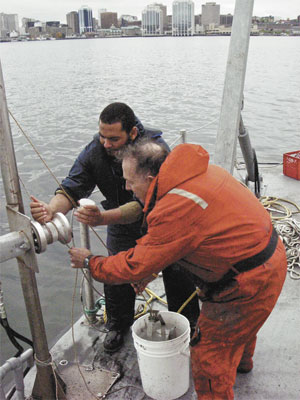 |
| PhD student Saad Mohamed and Prof. David Scott bring up sediment samples from the floor of Halifax Harbour. (Photo courtesy of David Scott) |
For two and a half centuries, as Halifax grew from a hardscrabble settlement to a thriving seaport, its “slops” have gone straight into the harbour.
The trickle of domestic waste in 1749 had turned into a tidal wave by 2003, the year Halifax Regional Municipality’s Harbour Solutions Project finally got underway. More than 180-million litres of raw sewage ended up in Halifax Harbour every single day. To put that number into perspective, that’s enough sewage to fill two 20-storey office towers, day after day after day.
Now that the Halifax plant, the biggest of the three new sewage plants, has been up and running for the past four months, the amount of sewage headed for the harbour has been cut by half, and the water is starting to improve.
But don’t get your bathing suit out yet —there are still 90 million litres of raw waste water sewage coursing through dozens of outfalls—pumping feces, toilet paper, pharmaceuticals, detergents, oils and fertilizers straight into the ocean. The Dartmouth plant is expected to be operational later this summer, followed by the Herring Cove plant by year end.
“Halifax Harbour is a large sink for organic matter,” says David Scott, professor of Earth Sciences at Dalhousie. “However, the water in the harbour is not the problem—it’s the sediment.”
Along with his team, Dr. Scott, a Killam professor and director of the Centre for Environment and Marine Geology, has recently received $200,000 in funding from Natural Sciences and Engineering Research Council (NSERC) to study the sediments on the harbour floor and match results with water quality data being collected by HRM. The project is supported by in-kind contributions by HRM, Bedford Institute of Oceanography, Department of Fisheries and Ocean and the Cultural and Educational Bureau of Egypt in Canada (in the form of PhD student Saad Mohamed).
The money allows the researchers to take core samples at various spots throughout the harbour. By examining these samples—both from the surface of the harbour floor and deep below—researchers will be able to reconstruct the history of pollution in the harbour and determine what it was like in its pristine state, circa 1749. They’ll also be able to monitor improvements in sediment after the $333-million Harbour Solutions Project is completed.
Most of the contaminants released in the water are absorbed or eaten by organisms in the water column or become attached to inorganic particles which then settle and accumulate in the sediment. Organisms are also recycled by bottom-dwelling creatures such as lobsters, clams and mussels. When examining core samples, the researchers will be looking for microfossils, called foraminifera, which faithfully record conditions from past environments.
The three Harbour Solutions plants are deemed “advanced primary,” explains James Campbell, communications project manager for Harbour Solutions. Sewage will pass through two levels of screens, a coarse screen and a finer screen, to eliminate particulates. The remaining waste water then goes through a grit removal chamber, eliminating smaller solids like salt and sand. Once all solids are removed, the waste water is subjected to ultraviolet light, which kills bacteria.
The treated sewage is then pumped through a diffuser pipe on the harbour floor and mixes with seawater. The entire harbour is flushed out twice daily by the tides.
“All that organic matter is what makes it so unpleasant to look at and smell,” says Dr. Scott. “Aesthetically, the harbour is going to look better, and some of the chemicals should be cleaned up too.”
As polluted as the harbour is, it could have been much, much worse. Compared to New Bedford Harbour in Massachusetts, for example, Halifax Harbour escaped heavy contamination by metals and toxic chemicals because of the lack of industries on its shores.
“That place – it’s just unreal. In New Bedford Harbour, they used to measure PCBs as a percentage rather than parts per million before remediation took place. It was that bad,” says Dr. Scott.
“Pollution that’s highly organic (as in Halifax Harbour) is much easier to treat with remediation and to bring it back to its pre-impact condition.”
LINKS: Halifax Harbour Solutions | Halifax Harbour, Natural Resources Canada
